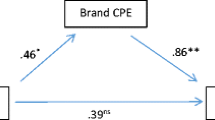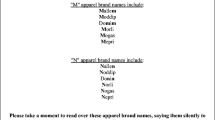Abstract
The staggering level and rate of growth of brands being introduced to the marketplace suggests a heightened need to understand how to create effective new brand names. Limited academic research, however, has been conducted in this area. This paper investigates the use of linguistics, specifically sound symbolism, in order to create brand names with inherent meaning. Results of two studies indicate that the sound of a brand name can communicate information about the product, e.g. its size, speed, strength, weight, etc. Brand name sounds can convey product-related information either in the presence or absence of supporting marketing communications.
Similar content being viewed by others
References
Aaker, David A. (1991). Managing Brand Equity. New York: The Free Press.
Amanuma, Y. (1974). Dictionary of Onomatopes and Expressives (in Japanese). Tokyo: Tokyodo.
Brown, Roger, (1958). Words and Things. New York: Free Press.
Chastaing, M. (1958). “Le symbolisme des voyelles: significations des 'I'”, I & II, Journal de Psychologie 55, 403–423 & 461-481.
Clark, John and Colin Yallop. (1990). An Introduction to Phonetics and Phonology. London: Basil Blackwell.
Enis, Ben M. and James E. Stafford. (1969). “Consumers' Perceptions of Product Quality as a function of Various Informational Inputs,” in Marketing Involvement in Society and the Economy, P. McDonald, ed. Chicago: American Marketing Association.
Erlich, Julie, (1995). “Giving Drugs a Good Name,” The New York Times Magazine, September 3, 36–37.
Fónagy, I. (1963). Die Metaphern in der Phonetik. The Hague.
Gabelentz, G. v. D. (1891). Die Sprachwissensschaft, ihre Aufgaben, Methoden und bisherigen Ergebnisse. Leipzig.
Gombrich, E. H. (1961). Art and Illusion. New York.
Grammont, M. (1901). “Onomatopées et mots expressifs,” Trentenaire de la Société pour l'étude des Langues Romanes, Montpellier, 261–322.
Grammont, M. (1913). Le vers francais: ses moyens d'expression, son harmonie. Paris.
Haas, M. R. (1969). “Internal Reconstruction of the Nootka-Nitinat Pronominal Suffixes,” International Journal of American Linguistics, 35, 108–124.
Hamano, Shoko. (1986). “The Sound-Symbolic System of Japanese.” PhD dissertation, University of Florida.
Hartley, Robert F. (1992). Marketing Mistakes, 5th Edition. New York: Wiley.
Hilmer, H. (1914). Schallnachahmung, Wortschoepfung und Bedeutungswandel. Helle.
Hinton, Leanne, Nichols, Hohanna, and Ohala, John. (1994). “Introduction: Sound Symbolic Processes”. In Hinton, Nichols, and Ohala (eds.), Sound Symbolism, Cambridge, England: Cambridge University Press.
Jakobson, Roman and L. R. Waugh. (1979). The Sound Shape of Language, Bloomington, IN: Indiana University Press.
Jesperson, O. (1918). “Nogle men-ord,” Studier tillegnade Esaias Tegner, Lund, 49–55.
Jesperson, O. (1933). “Symbolic Value of the Vowel i,” in Linguistica. Selected Papers in English, French and German. Copenhagen: Levin & Munksgaard, 283–303.
Karlgren, B. (1962). Sound Symbolism in Chinese, Hong Kong.
Keller, Kevin Lane, Susan E. Heckler, & Michael J. Houston. (1998). “The Effects of Brand Name Suggestiveness on Advertising Recall,” Journal of Marketing, 62 (January), 48–57.
Kim, Kong-on. (1977). “Sound Symbolism in Korean,” Journal of Linguistics, 13, 67–75.
Kotler, Philip H. (1991). Marketing Management: Analysis, Planning, Implementation, and Control, 7th ed., Englewood Cliffs, NJ: Prentice-Hall, Inc.
Ladefoged, Peter. (1975). A Course in Phonetics, New York: Harcourt Brace Jovanovich, Inc.
Lapolla, Randy J. (1994). “An experimental investigation into phonetic symbolism as it relates to Mandarin Chinese,” in Hinton, Nichols, and Ohala (eds.), Sound Symbolism, Cambridge, England: Cambridge University Press.
MacKay, Ian R. A. (1978). Introducing Practical Phonetics, Boston: Little, Brown and Co., Inc.
Martin, S. (1962). “Phonetic Symbolism in English Word-Formation,” Indogermanische Forschungen, 64, 146–168 & 256-277.
Morton, Eugene S. (1977). “On the Occurrence and Significance of Motivation-Structural Rules in some Bird and Mammal Sounds,” American Naturalist, 111, 855–869.
Morton, Eugene S. (1994). “Sound Symbolism and Its Role in Non-Human Vertebrate Communication”. In Hinton, Nichols, and Ohala (eds.), Sound Symbolism, Cambridge, England: Cambridge University Press.
Newman, Stanley S. (1933). “Further Experiments in Phonetic Symbolism,” American Journal of Psychology, 45, 53–75.
Nichols, J. (1971). “Diminutive consonant symbolism in Western North America.” Language 47: 826–848.
Ohala, John. (1984). “An Ethological Perspective on Common Cross-Language Utilization of FO of Voice,” Phonetica, 41, 1–16.
Ohala, John. (1994). “The Frequency Code Underlies the Sound-Symbolic Use of Voice Pitch,” in Sound Symbolism, eds. Hinton, Nichols, and Ohala, Cambridge, England: Cambridge University Press.
Peterfalvi, J. M. (1970). “Recherches expérimentales sur le symbolisme phonétique,” American Journal of Psychology, 65, 439–473.
Peterson, Robert A. (1970). “The Price-Perceived Quality Relationship: Experimental Evidence,” Journal of Marketing Research 7 (November), 525–28.
Peterson, Robert A, and Ivan Ross. (1972). “How to Name New Brands,” Journal of Advertising Research, 12 (6), 29–34.
Samarin, W. J. (1967). “Determining the Meanings of Ideophones,” Journal of West African Languages, 4, 35–41.
Sapir, Edward, (1929). “A Study in Phonetic Symbolism,” Journal of Experimental Psychology, 12 (June), 225–239.
Schloss Ira. (1981). “Chickens and Pickles,” Journal of Advertising Research, 21 (December), 47–49.
Schuchardt, H. (1897). “Keltorom. frog-, frogn-Lautsymbolik,” Zeitschrift fuer romanische Philologie, 21, 199–205.
Ultan, R. (1978). “Size-Sound Symbolism,” In Joseph Greenberg, (ed) Universals of Human Language, Volume 2: Phonology. Stanford: University Press.
U.S. Patent and Trademark Office 1997 Annual Report.
Vanden Bergh, Bruce G., Janay Collins, Myrna Schultz and Keith Adler. (1984). “Sound Advice on Brand Names,” Journalism Quarterly, 61, 4, 835–840.
Vanden Bergh, Bruce G., Keith Adler and Lauren Oliver. (1987). “Linguistic Distinction Among Top Brand Names,” Journal of Advertising Research, August/September, 39–44.
Whorf, B. L. (1956). Language, Thought and Reality, New York.
Yovovich, B. G. (1988). “What is Your Brand Really Worth?” Adweek's Marketing Week (August 8), 18–21.
Author information
Authors and Affiliations
Rights and permissions
About this article
Cite this article
Klink, R.R. Creating Brand Names With Meaning: The Use of Sound Symbolism. Marketing Letters 11, 5–20 (2000). https://doi.org/10.1023/A:1008184423824
Issue Date:
DOI: https://doi.org/10.1023/A:1008184423824




